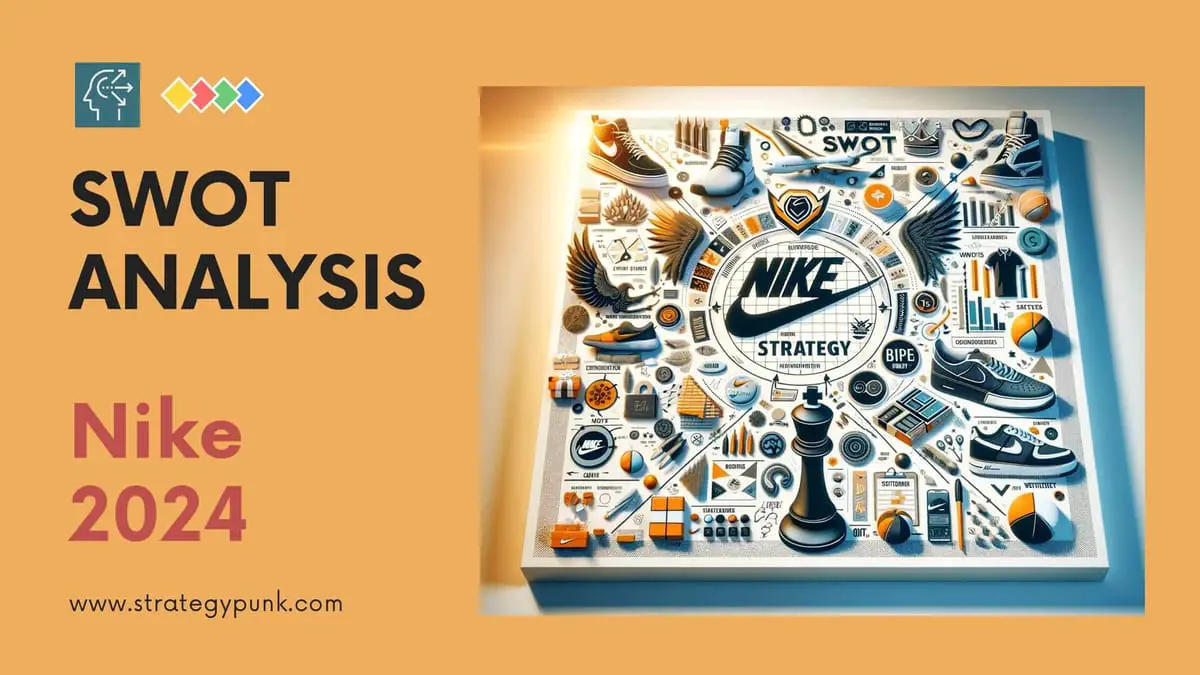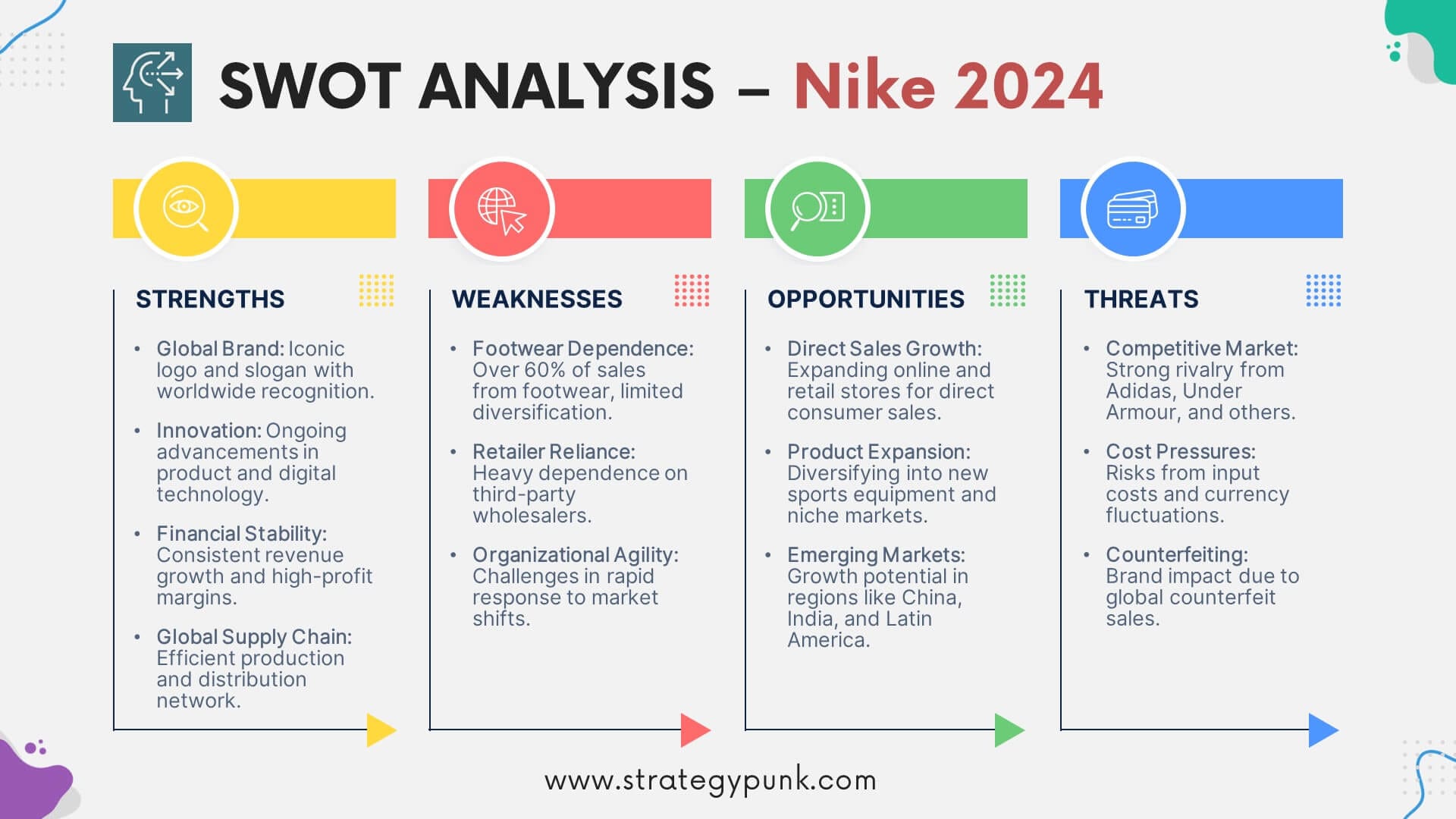Nike: Detailed SWOT Analysis with a Complimentary PowerPoint Template
Download Nike's 2024 SWOT Analysis: Comprehensive insights and free PowerPoint template. Key strategies, opportunities, and challenges revealed.

Introduction to the post
Welcome readers! The iconic Nike swoosh is one of the most recognizable logos in the world.
This post will conduct an in-depth SWOT analysis of Nike in 2024. Nike is the world's largest supplier of athletic shoes and apparel. We'll examine Nike's internal strengths and weaknesses, as well as its external opportunities and threats.
To make this analysis useful, we have also created a free, editable SWOT analysis PowerPoint template that summarizes the key takeaways.
Let's dive right in!
Introduction to Nike
Nike, Inc. is an American multinational corporation based in Beaverton, Oregon. It was established in 1964 as Blue Ribbon Sports by Bill Bowerman, a track-and-field coach, and his former student, Phil Knight.
Nike is the world's most extensive athletic footwear and apparel brand today. Its swoosh logo is one of the most recognizable brand symbols globally.
Nike employs over 75,000 people worldwide and manufactures athletic footwear, apparel, equipment, accessories, and services. It caters to various sports, including running, basketball, football, training, and more.
Some key facts about Nike:
- Founded: 1964
- CEO: John Donahoe
- Headquarters: Beaverton, Oregon
- Annual revenue (2023): $51.1 billion
- Net income (2023): $6.7 billion
Next, look at Nike's history and how it became the sportswear empire it is today.
A Brief Look at the History of Nike
Nike's journey began in 1964 when University of Oregon track athlete Phil Knight and his coach Bill Bowerman set up Blue Ribbon Sports. They started by importing running shoes from Japan's Onitsuka Tiger (now known as ASICS).
In 1971, Blue Ribbon Sports started making its footwear line, now marked with its famous "Swoosh" logo. The brand was renamed Nike in 1978, named after the Greek goddess of victory.
Nike's early innovations in footwear technology, such as the 1979 introduction of the Nike Air cushioning system, helped establish the brand as a leader in athletic footwear innovation. Its shoes were lighter, faster, and offered better shock absorption.
In the 1980s and 90s, Nike signed endorsement deals with celebrity athletes like Michael Jordan and Tiger Woods. The Air Jordan brand of basketball shoes brought Nike colossal success.
Nike also expanded aggressively overseas, mainly focusing on China's untapped market. Today, over half of Nike's sales come from outside North America.
Nike has consistently innovated with advanced proprietary technologies such as Flyknit, Dri-FIT moisture-wicking fabric, and the Nike+ digital ecosystem over the decades.
This focus on constant innovation and endorsement deals with top athletes have made Nike the most valuable sports brand in the world.
Financials of Nike 2024
Nike has released updated financial results for fiscal year 2024 and the first quarter of 2025.
Fiscal Year 2024 (June 2023 - May 2024):
- Annual Revenue: $51.4 billion, a slight increase from $51.2 billion in the prior year, representing a 1% growth on a currency-neutral basis.Nike Investoren
- Net Income: $5.7 billion, up 12% from the previous year.
- Earnings Per Share (EPS): $3.73, including restructuring charges. Excluding these charges, EPS would have been $3.95.
- Gross Margin: Increased by 110 basis points to 44.6%, primarily due to strategic pricing actions and lower logistics costs.
- Nike Direct Revenues: $21.5 billion, up 1%, with Nike-owned stores growing by 6%, partially offset by a 3% decline in Nike Brand Digital sales.
- Wholesale Revenues: $27.8 billion, up 1% on a reported basis and 2% on a currency-neutral basis.
- Regional Performance: Currency-neutral growth was noted in Greater China and APLA (Asia Pacific/Latin America), partially offset by a decline in North America.
First Quarter of Fiscal Year 2025 (June 2024 - August 2024):
- Revenue: $11.6 billion, a 10% decrease compared to the same period in the prior year, down 9% on a currency-neutral basis.Nike Investoren
- Net Income: $1.1 billion, a 28% decline year-over-year.
- Earnings Per Share (EPS): $0.70, down 26% from the same quarter in the prior year.
- Gross Margin: Increased by 120 basis points to 45.4% due to lower product costs and logistics expenses.
- Nike Direct Revenues: $4.7 billion, down 13%, primarily due to a 20% decrease in Nike Brand Digital sales, partially offset by a 1% increase in Nike-owned stores.
- Wholesale Revenues: $6.4 billion, down 8% on a reported basis and 7% on a currency-neutral basis.
- Regional Performance: Declines were observed across all geographies.
These results indicate that while Nike experienced modest growth in fiscal year 2024, it encountered challenges in the first quarter of 2025, including reduced revenues and net income.
The company recently underwent a leadership transition. Elliott Hill wasappointed President and CEO effective October 14, 2024. Hill aims to guide the company toward renewed growth.
In-depth SWOT Analysis of Nike 2024
SWOT stands for Strengths, Weaknesses, Opportunities, and Threats.

It is a structured framework to evaluate a company's strategic position by looking at internal and external factors.
Nike’s Strengths
Nike's key strengths are:
Global Brand Recognition: Nike's Swoosh logo and "Just Do It" slogan are recognized globally. It has built powerful brand awareness through decades of quality products and marketing.
Innovation Capabilities: Nike has continually innovated in product design, proprietary technology, and digital experiences. Its R&D infrastructure helps sustain the innovation pipeline.
Financial Performance: Nike has delivered consistent revenue and earnings growth historically. Its vertically integrated business model and high-margin Nike Direct sales underpin profitability.
Global Production & Distribution: Nike has well-established outsourced manufacturing capabilities and a solid global distribution infrastructure, ensuring efficient worldwide supply.
Nike’s Weaknesses
Some weaknesses Nike needs to manage are:
Over-reliance on Footwear: Footwear makes up over 60% of Nike's sales. It needs to diversify into apparel and accessories to drive sales growth.
Third-Party Retail Dependence: About 60% of Nike's sales come from wholesalers. As direct-to-consumer channels grow, managing third-party retail relationships is vital.
Lack of Agility: As a large company, Nike lacks the agility to respond quickly to market changes. It needs to streamline its structure and decision-making to become more nimble.
Nike’s Opportunities
Nike can capitalize on the following key opportunities:
Direct-to-Consumer Expansion: Nike can accelerate its online and retail store expansion to grow higher-margin direct sales.
New Products & Categories: Nike has growth headroom to expand into related categories like sports equipment and gear and launch new brands targeting niche consumers.
Emerging Markets: Nike has significant untapped growth potential in emerging markets like China, India, the Middle East, and Latin America through its localization strategy.
Nike’s Threats
Some threats Nike faces are:
Intensifying Competition: Rivals like Adidas, Under Armour, Lululemon, and local players are competing aggressively and eroding market share.
Margin Pressures: Input cost inflation, wholesale discounting demands, and foreign exchange fluctuations may compress Nike's healthy margins.
Counterfeits: Counterfeit Nike products illegally sold globally can negatively impact brand image and sales. Nike continues its brand protection efforts against counterfeiting.
Nike SWOT Analysis Summary
Internal Factors
Nike's substantial brand equity, innovation capacity, and financial track record are critical internal strategic advantages.
However, over-dependence on footwear and third-party distribution pose risks requiring mitigation focus.
External Factors
Favorable industry growth trends, potential for expanding into emerging markets, and avenues for direct sales growth present significant opportunities for Nike. However, pressures from competition, challenges related to margins, and risks posed by counterfeiting must be managed through targeted strategies.
Nike can retain its sportswear industry leadership by leveraging its strengths, overcoming weaknesses, seizing opportunities, and countering threats. However, it will require strategic clarity and effective execution.
Frequently Asked Questions
What are Nike’s most significant strengths?
Nike’s strengths are its robust global brand recognition, product development capabilities, extensive distribution network, and consistent financial results.
What are the major threats facing Nike?
Critical threats Nike faces are intensifying competition from brands like Adidas and Under Armour, counterfeiting its trademarks, and potential consumer spending declines in an economic recession.
What opportunities can fuel Nike's future growth?
Significant opportunities to spur Nike’s growth include expanding digital and e-commerce sales, entering developing markets, and showcasing sustainability credentials to attract socially-conscious shoppers.
What is Nike's competitive strategy?
Nike's competitive strategy is centered on product differentiation. It aims to offer athletic shoes and apparel with cutting-edge styles, technologies, and performance that stand out from rivals. Nike also invests heavily in signing endorsement deals with top athletes to enhance its aspirational and "cool" brand image.
How does Nike's marketing support its business strategy?
Nike's marketing reinforces its product differentiation strategy. Advertising campaigns spotlight product innovations and link Nike to elite athletic performance. Sponsorships of superstars like LeBron James and emotional storytelling around sports tap into consumers' passions. The goal is to strengthen Nike's brand prestige and premium positioning.
What sustainability initiatives has Nike undertaken?
Key sustainability initiatives for Nike include using recycled polyester and leather, eliminating virgin plastic in apparel, implementing renewable energy in owned facilities, and setting targets to cut carbon emissions across its supply chain. The Nike Grind program also recycles old athletic shoes into material for surfaces like running tracks and playgrounds.
How can sustainability provide Nike strategic benefits?
Sustainability can enhance Nike's branding among environmentally-conscious younger consumers who increasingly favor responsible companies. It also makes supply chains more resilient against climate disruptions and criticism regarding labor policies and waste. Furthermore, greener manufacturing can reduce costs over the long run as energy and material expenses decline.
Have there been any notable acquisitions in Nike's history?
Major past acquisitions fueled Nike's growth, including purchasing surf-inspired footwear brand Hurley International in 2002 and sports technology firm Celect in 2019. Both deals obtained Nike valuable intellectual property and innovative product designs. The Select takeover also bolstered Nike's data analytics capabilities for demand forecasting and inventory optimization.
Could Nike acquire other companies in the future?
Nike could acquire more petite sports apparel and accessories brands catering to specific consumer niches like yoga, cycling, or outdoor adventure. It might also pursue data analytics firms to improve its digital sales platforms and supply chain resilience. However, Nike already possesses a formidable scale, so it seems less inclined toward transformational mergers and more toward expanding organically.
Nike SWOT Analysis PowerPoint Template
free and fully editable PPT template
A SWOT analysis evaluates the strengths, weaknesses, opportunities, and threats impacting a company.
This free editable PowerPoint template provides a SWOT analysis framework to evaluate Nike's internal strengths and weaknesses and external opportunities and threats.
Download this pre-made SWOT analysis template to evaluate Nike's business strategy and document your SWOT conclusions. Customize it easily with your content.





